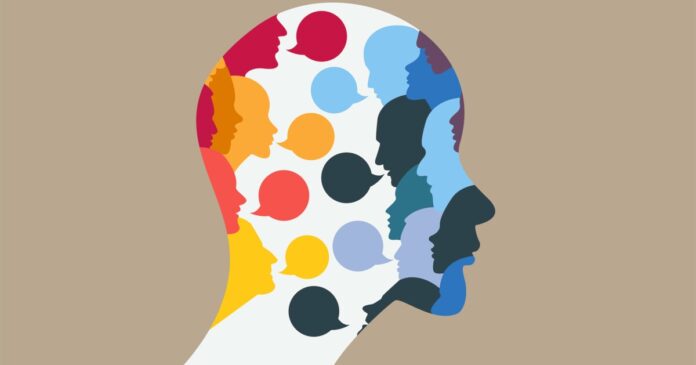For decades, scientists have suspected that the voices heard by people with schizophrenia might be their own inner speech gone awry. Now, researchers have found brainwave evidence showing exactly how this self-monitoring glitch occurs.
A longstanding theory proposes that the auditory verbal hallucinations experienced by people with schizophrenia may occur because the brain mistakes a person’s own inner speech for external voices, due to a breakdown in a mechanism called corollary discharge, a system that normally tells us, “I caused this sound.”
A new study co-led by the University of New South Wales (UNSW) Sydney and the Chinese University of Hong Kong (CUHK) has tested this theory, using recordings of brain activity to see whether auditory hallucinations in people with schizophrenia stem from the misattribution of inner speech.
“This idea’s been around for 50 years, but it’s been very difficult to test because inner speech is inherently private,” said the study’s joint lead and corresponding author, Thomas Whitford, PhD, a professor in UNSW’s School of Psychology. “How do you measure it? One way is by using an EEG, which records the brain’s electrical activity.
“Even though we can’t hear inner speech, the brain still reacts to it – and in healthy people, using inner speech produces the same kind of reduction in brain activity as when they speak out loud. But in people who hear voices, that reduction of activity doesn’t happen. In fact, their brains react even more strongly to inner speech, as if it’s coming from someone else. That might help explain why the voices feel so real.”
The researchers recruited 142 people in total, dividing them into three groups: 55 patients with schizophrenia (or related, schizophrenia-spectrum disorders) who were currently hearing voices; 44 patients with schizophrenia who weren’t hearing voices; and 43 healthy control participants. They were recruited from sites in Australia and Hong Kong, and their diagnoses were confirmed via standard psychiatric interviews.
Participants watched a moving line on a screen that cued them when to “say” a syllable silently in their heads (either ba or bi). At the exact same moment, a sound (ba or bi) was played through headphones.
Three conditions were tested: match (inner and outer syllables were the same), mismatch (inner and outer syllables were different), and passive (participants only listened; there was no inner speech). Brain activity was recorded using EEG, focusing on a specific brainwave pattern called the N1 component, which reflects how the auditory cortex responds to sounds. Normally, when we speak (even silently), our brain reduces its response to expected sounds. This is called “speaking-induced suppression” (SIS). The researchers wanted to see whether this inner version was reduced or reversed in people who hear voices.
The healthy control group showed the expected suppression pattern. Their brains had a smaller N1 response when inner and outer syllables matched (the inner SIS effect). This meant that their brains correctly recognized “I made that sound,” so the auditory response was reduced.
People with schizophrenia who experienced auditory hallucinations showed the opposite effect: an enhancement. When their inner speech matched the external sound, their brains had a stronger N1 response, as if the sound was more surprising. Meaning their brains failed to recognize the sound as self-generated, potentially leading to confusion between internal thoughts and external voices. Schizophrenics without auditory hallucinations didn’t show the normal suppression pattern either. They showed reduced responses in the Mismatch condition instead, which might mean they are partially impaired but less so than those with hallucinations.
In short, healthy brains dampened the response to self-generated speech, both spoken and imagined. Schizophrenic brains, especially in people hearing voices, failed to suppress and sometimes even amplified this response. This could make internally generated thoughts – “inner voices” – feel as if they’re coming from outside sources, thereby explaining auditory hallucinations.
“It was always a plausible theory – that people were hearing their own thoughts spoken out loud – but this new approach has provided the strongest and most direct test of this theory to date,” Whitford said.
Despite some limitations, including that some “non-hallucinating” participants had past experiences of hallucinations, so total separation of groups wasn’t perfect, and that the researchers didn’t distinguish between different hallucinatory types, the study’s findings have important clinical relevance. It could help identify individuals at risk of psychosis before symptoms appear. Treatments such as neurofeedback, brain stimulation, or targeted cognitive training might aim to strengthen or restore normal corollary discharge functioning. And, as the researchers point out, “inner speech suppression” could be used as a biomarker.
“This sort of measure has great potential to be a biomarker for the development of psychosis,” said Whitford. “Ultimately, I think that understanding the biological causes of the symptoms of schizophrenia is a necessary first step if we hope to develop new and effective treatments.”
The study was published in the journal Schizophrenia Bulletin.
Source: UNSW Sydney


